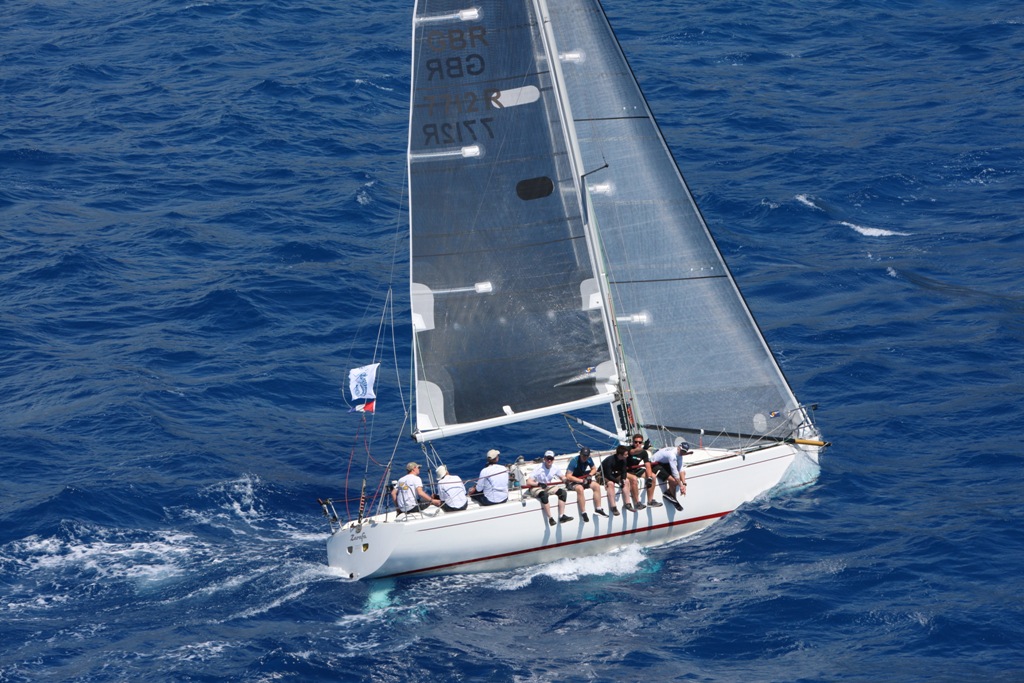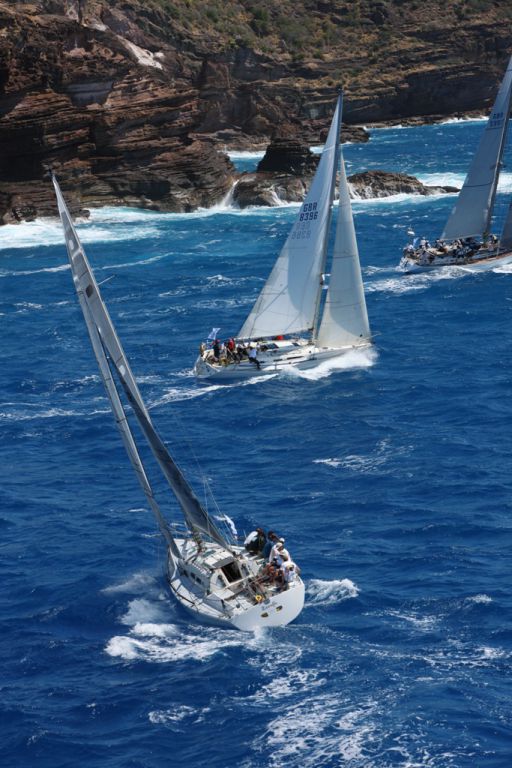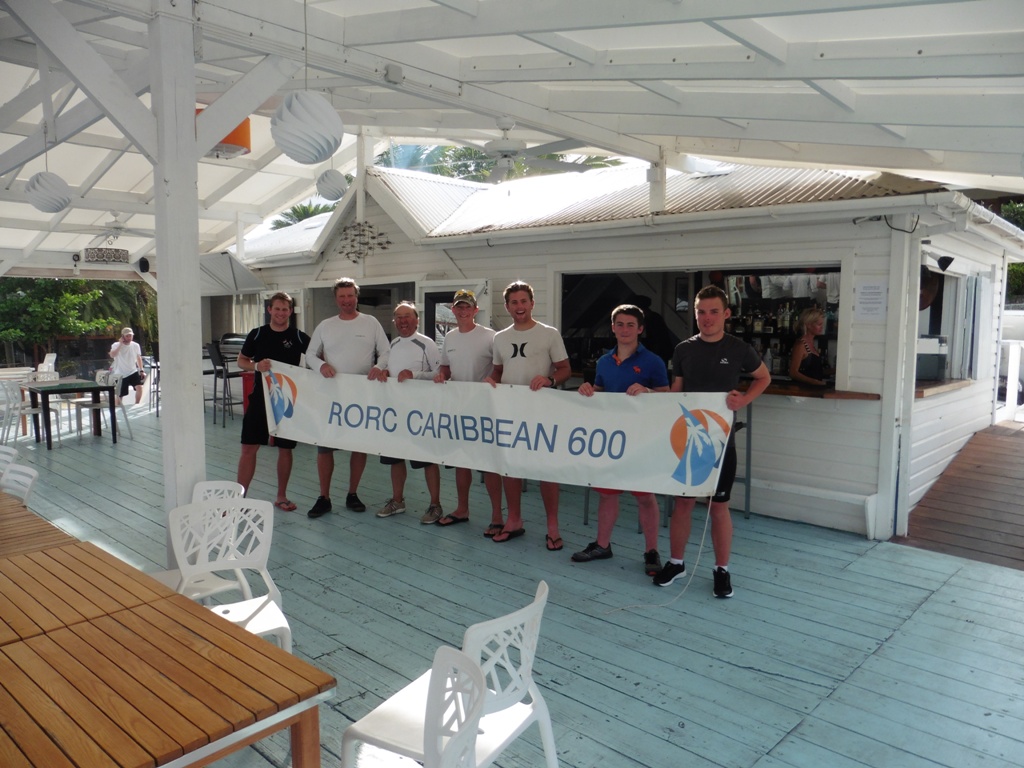

When one thinks of Caribbean sailing images of Pina Coladas, clear blue skies, sandy beaches and gentle sea breezes instantly spring to mind. Misconceptions of lazy days spent drifting on azure waters to the gentle accompaniment of steel bands ensure that the Royal Ocean Racing Club’s Caribbean 600 yacht race is the easiest race in the global offshore racing calendar to underestimate. What one is actually faced with when the starting gun goes is a snarling 605-mile ocean racetrack around the reef-strewn Lesser Antilles. The stable trade winds serve up a 20 knot kicking from the word go and high winds combined with large swells rolling in off the Atlantic, pitch black nights and plenty of rocky corners on the racecourse make for a truly challenging 600 mile classic. Squalls roll through the multinational fleet both day and night, setting traps for unwary crews who can find themselves caught in rapidly moving boat-breaking storms. Saltwater, big seas, top-level competition and killer groin chafe – This is by no means a race for the faint hearted!
Following on from Royal Armoured Corps Yacht Club entries into the race in 2012, ’13 and ’14 it was decided that, with the assistance of Maj (Retd.) Peter “Scho” Scholfield (RH), we would this year expand to complete a full sailing tour of the Caribbean using his 35 foot yacht Zarafa. The Caribbean 600 was to be leg 2 of this epic adventure with a real mix of abilities onboard.
Whilst the decision to use Zarafa did limit crew numbers (as a 35 footer can only take 8 crew offshore) it gave us two real advantages – we knew we were getting a race-proven yacht that several of us had sailed before and in Scho we knew we had an avid supporter of RAC/KRH sailing and an expert navigator. The rest of the crew included co-skipper Capt Henry Foster (KRH) and bowman Capt Charlie Gray (QRL) along with offshore racing novices Tprs Jake Sloan (KRH) and Tom Kirkby (QRL). We had two of Scho’s regular crew onboard and were meant to have a third but unfortunately he broke his shoulder shortly before departure so offshore virgin 2Lt Nic Bird (AAC but on attachment to the KRH) stepped into the breach – lending an “Air-Cav” flavour to our racing team.
Thus it was that Zarafa slipped her moorings in Admiral Nelson’s historic dockyard in Antigua and headed out into the teeth of the Caribbean on the morning of 23 Feb 15. For those that hadn’t done the race before misconceptions were instantly dispelled. As we donned our lifejackets and harnesses for the obligatory pre-race safety check it became apparent that this was to be no walk in the park. As one of the smallest boats in the 68-strong fleet we would be racing on handicap in class IRC 3. We would be taking our place on the start line against the top racing yachts in the world. Our motley crew of assorted cavalry and hangers-on would be up against seasoned ocean racing professionals on their sleek 120 foot carbon fibre steeds, record-breaking trimarans and thundering 300 foot superyachts. Right the way down to our end of the fleet there were professional racers and accomplished amateur skippers – we would have our work well and truly cut out.
Undaunted, with Scho on the helm and Henry Foster calling tactics, we hit the line in a good, if slightly conservative start. The wind was a solid 20 knots and Zarafa started to leap into the building seas as we fought to get clear of the bigger yachts around us. Making use of our shallow draft we pushed right into the cliffs and wriggled free, second in class on the water and going well. The first beat was a frantic baptism of fire for our novices as the big yachts began to scythe their way up through the fleet. Within inches of yachts twice our size Nic and Jake began to understand what they had let themselves in for, Tom was a little busy emptying his breakfast into the sea…
By the first turning mark at Barbuda things had settled down a little. A 30 knot squall had passed through but we had survived, two near collisions with bigger boats not paying attention had been avoided and we had picked up a slipstream off a bigger competitor. Finally we set the Code Zero then peeled to “the Hawk” (KRH branded A4 spinnaker!) and yachted off into our first night at sea with our favourite boil in the bag meals to see us into the watch system.
The first night at sea takes the fleet on a glorious downwind ride from Barbuda to St. Kitts and Nevis before you come back onto the breeze for a beat up to St. Barts on day two. At first all went well for us on Zarafa. Second in class up to the first beat, we were looking good and sailing nicely but the breeze began to drop as we headed upwind to St. Barts. Light airs are Zarafa’s Achilles’ heel and sure enough we began to drop back. Sail changes became more frequent and energy reserves were drained as the light wind and rising temperatures made concentration harder. We watched some of our more powerful competitors slide past and the race became a damage limitation exercise as we headed down to St. Maarten, beat through the Anguilla channel and fought back up to St. Barts into the second night.
By dawn on the third day the news wasn’t good. We had slipped to fourth in class on handicap and were fighting to stay in the top five. The 180 mile fetch down to Guadeloupe via Monserrat placed a premium on waterline length and our bigger, more powerful competitors had the edge. To make matters worse Tom was still struggling with seasickness, the hatches were leaking, the smell down below was getting a little fruity and we knew we had the dreaded wind shadow off Guadeloupe still to contend with. Nevertheless, morale remained high and we concocted a strategy that was to turn the class on its head and bring us back into contention.
The area to the west of Guadeloupe is infamous as the toughest part of the course to navigate successfully. The towering landscape of the island casts a wind shadow that can extend 8 to 12 miles out to sea and, as a result, Guadeloupe is where the race is often won or lost. The dilemma is the same for every afterguard – to go out as far as 15 miles offshore in an attempt to circumnavigate the wind shadow, sailing large amounts of extra distance, or head in as close to the coastline as possible to catch whatever breeze you can find rolling down off the hills and attempt to squeak through. On Zarafa we decided on the latter course of action, surmising that the extra distance sailed would cost us too much time. In the event we rolled a double six and cruised through the first part of the island’s lee. Nervous expressions at the back of the boat began to soften into grins and then almost incredulity as, despite shifting and gusting, the wind held and we sailed on through to the southern point of Guadeloupe and back out into the open sea. Our trimmers had worked tirelessly to punch through, with Nic Bird, Jake Sloan and Tom Kirkby (now slightly recovered) all doing tough stints on the sheets, and the relief was palpable. On the other hand our main competitors had gone offshore. We had nipped up their inside and pulled back our lost time, jumping three places to first in class on handicap by the time we settled into a long 25 knot beat up to Les Desirades.
The upwind leg from Guadeloupe to Les Desirades is always one of the hardest on the course. Lumpy seas and squalls of up to 30 knots throughout the night made for difficult conditions as we sought to maximise weight on the rail and push the boat hard in order to make gains. The inside of the boat now resembled a rather smelly washing machine and as we leapt off a particularly aggressive wave set we suffered our first casualty. One of our two civilian crewmembers took a tumble onto a winch and hurt the base of his spine. The net result was that he was forced to retire to a bunk for the last 36 hours of the race and Charlie Gray was sucked into the watch system, having previously been left available for sail changes and brew making. This was the darkest point in the race but some dogged determination and a fair amount of “grizzing it” from the troopers on the rail saw us continue our climb through the fleet. One by one masthead lights began to appear from in front. We weathered the storm and began to play the shifts up the southern coast of Guadeloupe. As dawn broke on the Thursday morning we rounded the rocky outcrop of Les Desirades (a little close for comfort) and felt that, although we were effectively one crewmember down, we had sailed a top-notch couple of legs.
From the Thursday morning we were onto the extended lap of Antigua before the final dash for home and by this point it was clear that class 3 had become a five-way battle. The race was on between us, a young professional British crew on Redshift skippered by Figaro sailor Nick Cherry, French duo and 2013 Fastnet top ten finishers on Raging Bee, the chartered Reflex 38 Intuition and the much bigger swan 46 Milanto. All these boats owed us time on handicap but all had differing relative merits. Redshift, Raging Bee and Intuition went much better off the breeze whereas Milanto and Zarafa needed some heavy wind beating to redress the balance. Therefore we knew as we popped the Code Zero and set off towards Barbuda and La Redonda that our main competition would be sailing at up to 20 knots and had two legs of gains on us that we would have to claw back towards the finish. Nevertheless we worked hard to minimise losses, pushing hard and hitting 11 knots on the reaches firstly to Barbuda and then down to La Redonda, 30 miles due west of Antigua.
Rounding La Redonda for the final 35 miles of the race we had gone back into “inshore mode”. Our principal helmsmen now came to the fore with the rest of the crew hiking the boat home. Despite slipping back on Redshift we had a lead on Intuition and Milanto whilst being neck and neck with Raging Bee for second. This was now our leg. As it got dark we plugged into the numbers and fierce concentration became the name of the game. Again we started heading into coastlines to make the most of flatter water and beneficial wind patterns around headlands, with Scho working hard down below to keep us off the reefs.
Slowly, out of the darkness, we started to reel in the boats in front on the water. 605 miles of racing boiled down to a few boatlengths as we realised that our upwind pace was again putting us into tacking battles with faster rated Figaro 2s. This was a good sign. Tack after tack ensued with all working to expend final energy reserves as we battled to the finish line off English Harbour, crossing at 0604 on the Friday morning after almost 3 days and 19 hours of tough racing – an extremely quick time for a boat of our size. Finally, out of the twilight, we began to make out some of our competitors. Finishing behind us on the water and owing us time on handicap the elation set in as we saw Raging Bee and Intuition cross the line, guaranteeing us second in a highly competitive class.
The final result saw us correct out some 25 minutes behind Redshift, second in IRC 3 and 20th overall. Everyone had had their problems over the course of what was a tough and windy race but this was a result of which our crew of mixed ability could be justifiably proud. We had sailed to our handicap, made some cracking decisions, pushed both boat and crew hard and survived intact. We had pushed a professionally crewed boat the whole way and finished ahead of some extremely talented sailors – this was also the best result that the RAC has achieved in four consecutive attempts at the race. Next stop the top of the podium in 2016!
The crew after the finish: (L-R) Steve Davies, Capt Charlie Gray, Malcom Hawksworth, Maj (Retd.) Peter Scholfield, Capt Henry Foster, 2Lt Nick Bird, Tpr Jake Sloan, Tpr Tom Kirkby
Please note: This hugely ambitious 4 month sports tour would not be possible without the generous support of Peter “Scho” Scholfield, whose enthusiasm for getting serving personnel out sailing is unparalleled and critical to our success. We are also grateful to a number of organisations including the regiments of the RAC, the RAC/HCAV Central Fund, Tidworth and Bulford Garrison, the Army Sports Lottery and the Berlin Infantry Brigade Memorial Trust Fund who have committed significant amounts of funding to ensure that serving soldiers are able to take advantage of this incredible opportunity.